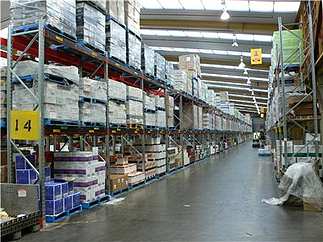FMCG and Brewing producers amongst many others, carefully pack their products to meet exacting requirements for International Key Account (IKA) and Local Key Account (LKA) customers. Increasingly this includes specially collated and shrink-wrapped pallets which are cross-docked to specific stores via a retailer platform. Powerful retailers force Producers to operate to strict standards of service whether this is case fill, OTIF, CCFOT, fill level or some other agreed measure designed to ensure products reach the shelf on time. Similarly, in quality terms any damages or close to expiry product is usually rejected even if it means empty shelf space.
If a platform is in use then this may be where the Producer liability ends but that is unlikely and in any case an empty shelf directly hurts the brand owner more than the retailer. So let us assume the carefully packed and stretched pallet of assorted goods arrives at the rear of the store on time, in full and in good condition. The next piece of the chain is called the “last 50 yards/metres”; that relatively short distance from back of store warehouse to the shelf.
If you have never seen a retailer back of store warehouse operation then you should, and soon. Some may indeed be slick, finely tuned operations continuously pumping product towards consumers. Take a look behind those dirty plastic flaps and see what is going on. Be careful when doing this as at any minute a fork lift truck with Retail Stig in the saddle will burst forth with plastic a-flapping and horn a-blazing. Without any apparent care for consumers or himself Retail Stig charges past the frozen food, takes a good line past the mop heads gondola before squealing the tyres around the bon-bons and across the line! You did it …..in……shouts a manic Clarksonesque store manager.
 Anyway, where was I? You will find that a majority of store warehouses will be badly organised and chaotic - perhaps chaos is inherent as you do need momentum and energy to keep the stocks moving. I believe the overriding problem is that while the rest of the chain is largely controlled by skilled supply chain professionals the back of store is not. To be fair some stores are staffed by skilled individuals but the organisation has a sales mentality rather than a supply chain focus. Just because the stock is now in a “shop” there is no logical reason why the required skills should be any different.
Anyway, where was I? You will find that a majority of store warehouses will be badly organised and chaotic - perhaps chaos is inherent as you do need momentum and energy to keep the stocks moving. I believe the overriding problem is that while the rest of the chain is largely controlled by skilled supply chain professionals the back of store is not. To be fair some stores are staffed by skilled individuals but the organisation has a sales mentality rather than a supply chain focus. Just because the stock is now in a “shop” there is no logical reason why the required skills should be any different.
Many Producers have recognised this and have started coaching retailers in the “last 50 yards” to transfer basic supply chain skills and procedures. Some simple initiatives like pallet marking on floors, FIFO and easy access to fast movers will pay rapid dividends to both parties and stop some of the pointless conflict that seem to feature in Producer-Retailer relationships. This is not rocket science!
And on that bombshell……..
Image credit: Colliers International







